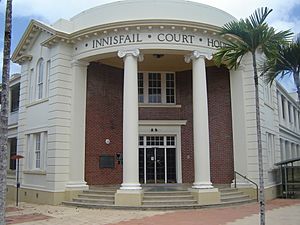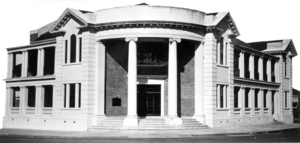Innisfail Court House facts for kids
Quick facts for kids Innisfail Courthouse |
|
|---|---|

Innisfail Courthouse
|
|
| Location | 10 Edith Street, Innisfail, Cassowary Coast Region, Queensland, Australia |
| Design period | 1919 - 1930s (interwar period) |
| Built | 1939 - 1939 |
| Architect | Department of Public Works (Queensland) |
| Architectural style(s) | Classicism |
| Official name: Innisfail Court House | |
| Type | state heritage (built) |
| Designated | 13 January 1995 |
| Reference no. | 601578 |
| Significant period | 1930s |
| Significant components | office/s, court house |
| Builders | Day labour |
| Lua error in Module:Location_map at line 420: attempt to index field 'wikibase' (a nil value). | |
The Innisfail Court House is a special old building in Innisfail, Australia. It's located at 10 Edith Street. This building is the third court house in the town's history. It was designed in a classic style by the Department of Public Works (Queensland) and built in 1939. The court house is a two-story building made of brick with a corrugated-iron roof. It was added to the Queensland Heritage Register in 1995 because of its important history and design.
Contents
A Look Back: Innisfail's Court Houses
The Innisfail Court House opened in March 1940. It replaced an older timber building from 1888. The new court house was designed by the Department of Public Works (Queensland). At that time, Andrew Baxter Leven was the main architect for the Queensland Government.
How Innisfail Began
The area around the Johnstone River was first settled by people cutting cedar trees. In 1880, the first major sugar cane farms were planted. A man named T.H. Fitzgerald is known for planting the first sugar cane. He also built the first sugar mill in the area in 1881.
In 1881, a town was planned where the South Johnstone and North Johnstone Rivers meet. It was first called "the Junction." In 1883, the town's name became Geraldton.
Early Buildings in Geraldton
Around 1881, Geraldton got its first official building. It was probably on the police land. This building held many important offices. It had a police station, a court house, a post office, a lands office, and a customs office. It also had an office for the Clerk of Petty Sessions and a jail.
In late 1887, plans were made for a new court house. These plans showed the building would be on the corner of Edith and Rankin Streets.
Innisfail's Growth and Challenges
The town's name changed from Geraldton to Innisfail in 1910. By the early 1900s, many people were interested in the Innisfail area. The Queensland Government planned to open up Mourilyan Harbour. They also wanted to extend the local tram line. These plans helped the area grow even more.
Innisfail faced big challenges. In 1913, a huge flood hit the town. Then, in 1918, a cyclone destroyed many timber buildings. But the town kept growing! In 1916, its third sugar mill opened.
After World War I, land was given to soldiers who returned home. This was called "soldier settlement." In 1922, some land was set aside for these soldiers to grow sugar cane.
A Time of Prosperity
The North Coast railway from Brisbane to Cairns was finished in 1924. This helped the district develop even more. By the 1920s, Innisfail's sugar industry was very successful. It produced huge amounts of sugar cane. This brought a lot of money to the town.
Because of this wealth, many strong buildings were built in the 1920s and 1930s. These included important public buildings like the hospital's first part, the Roman Catholic Church, and the Commonwealth Bank. The opening of the Jubilee Bridge in 1923 was also important. It connected the town to East Innisfail and Mourilyan. The Dardgee Railway Bridge opened in 1924.
Building the Current Court House
Officials knew that Innisfail would need bigger court facilities. This was because the town was growing and had more legal business. In 1937, plans for a new court house were finally drawn up.
The plan was to build a new two-story brick court house. It would stand where the old timber court house was. The old timber court house would be moved to the east. It would then be used by the police for offices and barracks.
During the 1930s, Australia faced the Great Depression. This was a time when many people lost their jobs. To help, William Forgan Smith, the Premier (leader) of Queensland, started a government work program. This program hired architects, foremen, and workers. It used local materials to build government buildings. These included court houses, government offices, and schools. The Innisfail and Mackay court houses are great examples of these strong brick buildings.
The new Innisfail Court House was finished in late 1939. The ground floor had offices for different government departments. The court room and other court facilities were on the first floor. Some small changes have been made to the building over the years, like adding an air conditioning area.
In 2006, when Cyclone Larry hit, the court house was a central place for helping with the relief efforts.
What Does the Court House Look Like?
The Innisfail Court House is designed in a style called "inter-war classical." It's a two-story building made of brick. It has a corrugated-iron roof. The decorative parts on the gables (the triangular parts of the wall under the roof) and verandahs are smooth and finished.
A curved entrance area, called a portico, welcomes you to the building. It faces the corner of the street. This portico has two large columns with special tops called Ionic capitals. A tall verandah runs along each side of the building that faces the street. The gables have broken pediments (triangular decorations) and Venetian windows.
Why is it a Heritage Site?
The Innisfail Court House is listed on the Queensland Heritage Register. This means it's considered very important to Queensland's history and culture. It meets several special requirements:
Showing Queensland's History
This building was finished in 1939. It was the third court house in Innisfail. It shows how Innisfail grew from the late 1800s. The town became an important business and official center. It also shows the wealth that came from the sugar industry growing in the Johnstone area in the early 1900s.
A Great Example of its Kind
The Innisfail Court House is a good example of a strong brick court house. It shows the high quality of government buildings designed by the Department of Public Works in the early to mid-20th century.
Beautiful and Important Design
The way the building is shaped, its size, and the materials it's made from are important. They make the Edith and Rankin Street areas look special. The building adds a lot to the overall look of Innisfail town.
Special Connection to the Community
The Innisfail Court House was designed and built as part of a government plan. This plan aimed to create jobs across Queensland during the 1930s Great Depression. So, the court house is also a great example of the important work done under this program.


